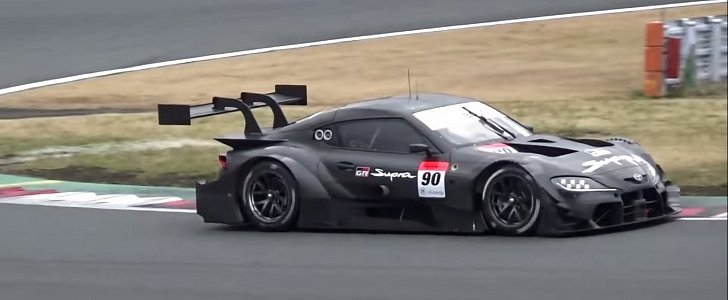Over the course of four minutes and a handful of seconds, the following video treats you to a GR Supra unlike the series-production model in more than a few ways. The biggest difference – except that it’s not street legal – is the RI4AG turbocharged four-cylinder engine that sounds like a bunch of angry hornets coming out of the combustion chambers to wreak havoc on your eardrums.
“What? They make Supras with four cylinders now?” The RI4AG is not your average BMW plant. Manufactured by Toyota Technocraft in accordance with Class 1 regulations, this bad boy pushes more than 600 horsepower from 2.0 liters of displacement. By comparison, the B48 in the road-going model specific to the Japanese market is rated at 194 or 255 brake horsepower.
The 4AG moniker harks back to the 4A-GE engine in the AE86 Corolla Levin and AE86 Sprinter Trueno. A later version of this blunderbuss leveled up to five valves per cylinder, and even a Corolla could be specified with it.
Turning our attention back to the GR Supra GT500, the track-only monster will replace the Lexus LC 500 in the Super GT series. Its main rivals are the NSX and GT-R, and in the case of the Honda, the engineers had to relocate the engine over the front axle to comply with the 2020 season’s regulations.
Based on the aerodynamic setup, the maximum velocity of a Class 1 racecar is estimated at 186 miles per hour (300 km/h) based on the latest round of testing. The transmission of the GT500 is also different from the ZF 8HP in the GR Supra, a sequential transmission with a motorsport-style clutch paddle.
Class 1 regulations also apply to the DTM, which adopted them at the beginning of the 2019 season. The biggest change to the Deutsche Tourenwagen Masters in recent history includes a 9,500-rpm limit for the engine, Garrett turbocharging, and push-to-pass overtake assist.
Because the 4.0-liter V8 is gone, the minimum weight of DTM racers has also dropped to 1,070 kilograms including the driver and a full tank of gasoline. Two more changes are worthy of note, namely the ban of launch control and the switch to a rearview camera instead of a traditional mirror.
The 4AG moniker harks back to the 4A-GE engine in the AE86 Corolla Levin and AE86 Sprinter Trueno. A later version of this blunderbuss leveled up to five valves per cylinder, and even a Corolla could be specified with it.
Turning our attention back to the GR Supra GT500, the track-only monster will replace the Lexus LC 500 in the Super GT series. Its main rivals are the NSX and GT-R, and in the case of the Honda, the engineers had to relocate the engine over the front axle to comply with the 2020 season’s regulations.
Based on the aerodynamic setup, the maximum velocity of a Class 1 racecar is estimated at 186 miles per hour (300 km/h) based on the latest round of testing. The transmission of the GT500 is also different from the ZF 8HP in the GR Supra, a sequential transmission with a motorsport-style clutch paddle.
Class 1 regulations also apply to the DTM, which adopted them at the beginning of the 2019 season. The biggest change to the Deutsche Tourenwagen Masters in recent history includes a 9,500-rpm limit for the engine, Garrett turbocharging, and push-to-pass overtake assist.
Because the 4.0-liter V8 is gone, the minimum weight of DTM racers has also dropped to 1,070 kilograms including the driver and a full tank of gasoline. Two more changes are worthy of note, namely the ban of launch control and the switch to a rearview camera instead of a traditional mirror.










